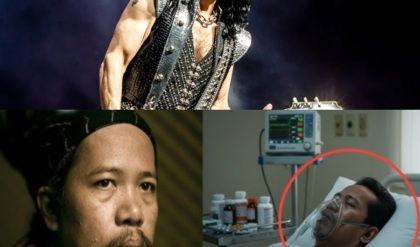SHOCK AND CHAOS IN CEBU: A NATION WATCHES IN TERROR AS BOGO CITY HOSPITAL STRUGGLES AFTER DEVASTATING 6.9 MAGNITUDE EARTHQUAKE
On a seemingly ordinary Tuesday morning, the bustling streets of Bogo City, Cebu, were abruptly transformed into a nightmare. Residents went about their routines, children played in open spaces, and vendors prepared for another day of business. But within moments, the ground beneath them roared with a force that no one could have anticipated. A 6.9 magnitude earthquake struck the province, leaving destruction in its wake, shaking not just the foundations of buildings but also the hearts of every Filipino who witnessed the aftermath.

The epicenter, located near Bogo City, sent shockwaves through neighboring towns and provinces, collapsing homes, toppling walls, and causing widespread panic. Emergency services were immediately deployed, yet the scale of the devastation quickly became overwhelming. Among the hardest-hit locations was the Cebu Provincial Hospital in Bogo City — a medical facility that became both a sanctuary and a scene of unimaginable horror.
Inside the hospital, chaos reigned. Patients, some already battling severe illnesses, were forced to navigate crumbling corridors and damaged wards. Medical staff, exhausted yet unyielding, scrambled to tend to the increasing number of injured while maintaining order amid the growing panic. Stories of heroism emerged: nurses carrying unconscious patients down fractured staircases, doctors performing life-saving procedures under flickering lights, and volunteers forming human chains to transport the wounded to safety. Yet for all their efforts, the hospital was being pushed to the brink.
Witnesses described the scene as apocalyptic. Windows shattered, ceiling tiles crashed to the ground, and the constant rumble of aftershocks made it nearly impossible to maintain calm. Families clung to one another, some desperately searching for missing loved ones amid the chaos. The cries of children, the wails of mothers, and the guttural groans of the injured formed a haunting symphony of human suffering that echoed far beyond the hospital walls.

The death toll, reported to be climbing by the hour, has become the focal point of national concern. Initial counts were already staggering, and as rescue teams continued their desperate search, it became clear that the number of casualties could rise even further. Each name added to the list is not just a statistic but a life, a story cut tragically short. Social media quickly erupted with heart-wrenching images and videos from survivors and witnesses, documenting the terrifying aftermath in vivid, unfiltered detail.
Outside the hospital, streets were littered with debris. Vehicles lay crushed beneath fallen structures, utility poles snapped like matchsticks, and dust clouds hovered over the city like a persistent fog of despair. The normally lively marketplaces were eerily silent, save for the occasional siren of an ambulance or the frantic shouts of volunteers coordinating rescue efforts. Entire neighborhoods were left without power or communication, and families waited anxiously for any news, their fears amplified by the uncertainty of aftershocks that continued to shake the region throughout the day.
National leaders, emergency response agencies, and local government units were forced into rapid action. President Rodrigo Duterte addressed the nation in a somber televised statement, expressing grief for the victims while assuring the public that rescue operations were underway. Relief efforts were mobilized from neighboring provinces, and international aid offers began to pour in. But even with the mobilization of resources, the enormity of the disaster meant that response teams were often stretched thin, facing the harrowing reality that every second counted and that many lives hung in the balance.

Survivors’ accounts paint a harrowing picture. One nurse described holding a mother and her injured child as they waited for evacuation, recounting the mother’s desperate pleas for help and the child’s terrified sobs. A doctor shared how he performed emergency procedures on patients trapped under rubble, often with minimal equipment and in precarious conditions. Volunteers spoke of navigating crumbled roads and falling debris to deliver water, blankets, and medical supplies, often at the risk of their own safety.
Social media became both a lifeline and a source of collective anxiety. Hashtags related to Bogo City and Cebu began trending nationwide, as concerned Filipinos attempted to locate loved ones, share updates, and spread awareness about urgent needs. Crowdfunding campaigns emerged within hours, seeking to provide food, medicine, and temporary shelter for those affected. Meanwhile, international news outlets began covering the story, emphasizing not just the physical destruction but also the profound emotional and social impact of the disaster on the local communities.
The psychological toll of the earthquake cannot be overstated. Survivors report trauma, panic attacks, and sleepless nights, while families mourn the sudden loss of breadwinners and loved ones. Local schools and businesses remained closed as the community grappled with the shock, and counselors and support groups were quickly deployed to provide mental health assistance. Experts warned that recovery would require more than rebuilding infrastructure—it would demand addressing the emotional scars left by such a catastrophic event.
Meanwhile, the Philippine Red Cross and other humanitarian organizations worked tirelessly to establish temporary shelters for displaced families. Makeshift camps were set up in open fields, gymnasiums, and community centers, offering basic necessities such as food, water, and blankets. Volunteers coordinated with medical teams to ensure that those injured or sick received immediate care, while engineers and safety inspectors evaluated damaged buildings to prevent further collapses.
Despite the ongoing chaos, stories of bravery and solidarity shone through the despair. Residents banded together to help each other evacuate, distribute supplies, and search for missing neighbors. Strangers became heroes, offering assistance without hesitation, and local leaders displayed remarkable resilience in coordinating rescue and relief efforts under unimaginable pressure. The crisis revealed both the vulnerability and the strength of the human spirit, as the people of Bogo City faced one of the most devastating challenges in recent memory.
Yet amid the heroism, questions and frustrations emerged. Many criticized the preparedness of local infrastructure, the adequacy of emergency protocols, and the speed of response from government agencies. Analysts highlighted that while natural disasters are inherently unpredictable, the lessons from past earthquakes could have informed better urban planning, construction standards, and community readiness programs. The tragedy of Bogo City may serve as a painful reminder that prevention and preparedness are just as vital as response and recovery.
As night fell over Cebu, the situation remained critical. Hospitals overflowed, shelters struggled to accommodate the displaced, and families anxiously awaited news about loved ones still trapped or missing. Search and rescue teams worked tirelessly, often in dangerous conditions, guided by both courage and urgency. The echo of the earthquake continued to reverberate—not just in the trembling ground, but in the hearts and minds of all Filipinos witnessing the unfolding tragedy.
Media coverage amplified both the urgency and the humanity of the disaster. Live reports from reporters on the scene captured the raw emotion, chaos, and resilience of those affected, while social media offered a platform for ordinary citizens to share their experiences, appeals for help, and stories of survival. Each image, video, and firsthand account added to a growing narrative of tragedy, heroism, and hope amidst destruction.
In the following days, attention would shift to the long-term challenges of recovery: rebuilding homes, restoring infrastructure, providing ongoing medical care, and addressing the psychological impact of trauma. Aid organizations, government agencies, and local communities faced the enormous task of rebuilding not just the city but the lives of the people who had been irrevocably affected by the earthquake.
Yet even amid devastation, glimmers of hope persisted. Communities came together in ways previously unimaginable, neighbors supported one another through acts of courage and kindness, and volunteers from across the country and abroad converged on Bogo City to assist in relief operations. These acts of solidarity became symbols of resilience, offering a counterpoint to the chaos and despair that initially gripped the city.
The earthquake in Bogo City, Cebu, serves as a sobering reminder of the power of nature, the fragility of human infrastructure, and the resilience of the Filipino spirit. From shattered buildings and crowded hospitals to emotional reunions and heroic rescues, the events of that Tuesday left an indelible mark on the community, the province, and the nation. As the recovery process continues, the stories emerging from the disaster will serve as both cautionary tales and testaments to human courage, perseverance, and compassion in the face of overwhelming adversity.
In conclusion, the 6.9 magnitude earthquake that struck Bogo City has shaken more than just the ground—it has shaken the hearts of millions across the Philippines. The images and stories from Cebu Provincial Hospital, combined with the collective response of ordinary Filipinos and heroic rescuers, remind the nation of the fragility of life and the enduring strength of community. While the death toll continues to climb and the path to recovery remains arduous, the courage, unity, and resilience displayed in the aftermath offer a glimmer of hope that even in the darkest moments, humanity’s light can shine brightest.





